WAGtv’s “Ancient X-Files” Voynich episode will first air at 20:40 on 10th May 2012 on the National Geographic channel in France, where the series has been retitled “De l’ombre à la lumière“. Though the episode is entitled “Sodom and Gomorrah” (“Sodome et Gomorrhe” in French), be reassured that 50% of it is the Voynich part. 🙂
And by a nice coincidence which Nat Geo’s schedulers seem, errrm, mostly unaware of, this is also when I shall be in Frascati preparing for the upcoming Voynich Centenary conference the following day. It’s time to tell some of the story behind the documentary…
1. “The Curse of the Voynich” Meets WAGtv…
Back in 2006, the general consensus was that the Voynich Manuscript was an extraordinary late 16th century hoax, constructed to part an extraordinary fool (Holy Roman Emperor Rudolf II) from his extraordinary money (600 gold ducats). And without the 2009 radiocarbon dating (which dated its vellum to 1404-1438 with 95% confidence) to help ground the whole debate, the Voynich was arguably even more like a blank historical canvas (upon which you can paint whatever theory you like) than it is today. Sad, really.
2006 was also the year that I wrote and published “The Curse of the Voynich” (copies still available, and at very reasonable air mail rates 😀 ), with the aim of summing up the research I had built up over several years – basically, that the Voynich Manuscript may well have been written by Northern Italian Quattrocento architect Antonio Averlino (better known as “Filarete“).
However, put these two things together and it should be no great surprise that, a couple of nicely appreciative reviews aside, my tree of research fell onto the Voynich research community’s forest floor with a deafening silence. (If, indeed, it fell at all.) Personally, I still think my book is a great piece of historical detective work (I posted a nice summary of it here), but I suspect it remains too “out there” for almost all Voynich researchers, most of whom seem to rely more on lightweight inductive logic than on the kind of heavyweight hyper-deduction I had to employ. 🙂
Fast forward to early 2010, when London-based factual television production house WAGtv were working on the the first series of Ancient X Files for National Geographic. Their producers approached me to ask if I would contribute to a 22-minute documentary segment based on “The Curse of the Voynich”: though it just missed the cut for series 1, I was delighted to be able to take part when they subsequently wanted to include it in series 2.
This whole Voynich segment was filmed over five days last summer [2011] in locations centrally linked to Antonio Averlino’s life and works, such as the Ospedale Maggiore & Castello Sforzesco in Milan, and the Campanile in Venice (looking down onto the onion domes of St Mark’s Basilica). Just so you know, the televisual conceit was to visually reconstruct the evidence chain and associated reasoning that led to my whole Averlino theory. In case your inner historian finds this somewhat annoying, please take a few deep breaths and remind yourself that “it’s just television” – if you want to read up on it properly, there is at least a 230-page book you can buy that presents all the evidence in a reasonably compelling way. 😉
2. Meet The Experts…
Naturally, there are few things more boring than seeing some random expert (yes, even me) expound to camera for 20+ minutes (which is, of course, why Dr Who always has an assistant). Hence the producers assembled a delightfully eclectic set of experts for me to talk with on camera, basically with the idea of placing the various deductive leaps I patiently ground out of the academic literature into their helpful mouths:-
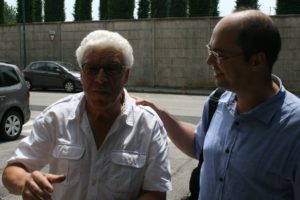
Filippo Sinagra, a well-known Venetian code-breaker with a lifelong interest in historical & Mafia ciphers;
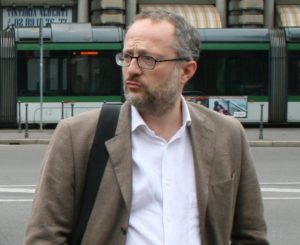
Stefano Calchi Novati, a Milanese architect (whose motorbike I sadly couldn’t ride because of insurance issues);
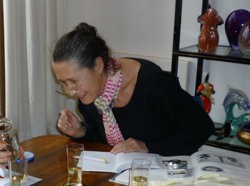
Rosa Barovier Mentasti, a thoroughly delightful glassware expert descended from the Murano glassmaker Angelo da Barovier, but whom I somehow managed not to capture on camera (the image is from Mauro Vianello’s nice glass blog);
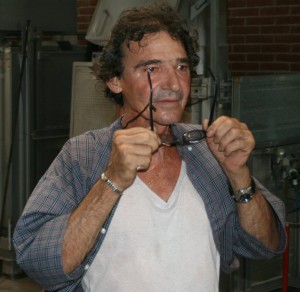
A magnificent Murano master glassblower whose name unfortunately escapes me, and whose wonderfully rich Venetian accent proved near-impenetrable even to our Italian translator; and…
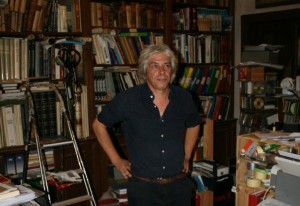
Well-known Venetian architect and historian Francesco da Mosto, presenter of several top-rated BBC series with the power to make many British women of a certain age swoon unashamedly.
OK, now that we’ve got past all the raw factuality, what really happened while filming?
3. Nine Top Secret Things That Happened On The Shoot
(1) I’d only previously been to Venice out of season (if you’re going, I recommend December), and July 2011 turned out to be a raging heatwave. Despite that, John Blystone (the director) had me marching back and forth across endless Venetian bridges to the point that I nearly got heatstroke, and had to sit down in a quiet corner eating ice cream for an hour while I cooled all the way back down to merely hot. Note that I don’t hold this against him – John’s a driven guy and wanted to get the best possible coverage going into the edit, and if he can make a bald historian bloke like me come out tolerably OK on camera, I have to say he’s pretty much on fire. 🙂
(2) While getting over heatstroke, I found out that Cesira (the translator) used to run short film festivals, though she bemoaned the fact that Italian film-makers were typically so talky that they thought 20 minutes should qualify as ‘short’. I then told her how I used to write stories in 30 words or less as a writing challenge: she didn’t believe that that was even remotely possible, so insisted I write her one there and then. Knowing that the crew was flying on to Rome to film a Da Vinci-related segment, this is what I squeezed into a mere 15 words:-
“Not again, Lisa!”
“What?”
“Every time you fart, you do that smile.”
“Sorry, Maestro Leonardo!“
(3) While in the Piazza San Marco, I suddenly noticed that the columns of San Marco and San Theodoro were leaning very slightly towards each other. Luckily I managed to straighten them up before any tourists got crushed by falling stones: an excellent result!
(4) I’d be a lying hound if I didn’t say it was more than a bit of a thrill meeting Francesco da Mosto & his lovely family in their Venetian palazzo, and lightly zipping around the canals with him in his near-iconic blue boat. Francesco is an enthusiastic, positive, laughter-filled big-kid-puppydog of a man that made me want to smile every time he opened his mouth: probably half the shots were ruined because we were having too much fun to look serious in an appropriately documentary-style way. I love the guy to bits, and wish him the very best of luck with finishing his historical novel “The Black King” (which, spookily enough, one online description I read said revolved around John Dee and a mysterious enciphered manuscript).
(5) When we got back to San Marco after filming (and eating late) in Murano, the tide was so high that we couldn’t get a boat into the canal near the apartment (“Casa Cioccolata”, a nice little place). This meant the crew had to carry all the equipment barefoot across the waterlogged piazza in the moonlight: a thoroughly surreal experience!
(6) Once nice thing in Venice which didn’t make it into the final edit was that the newly-restored clock tower close to St Mark’s Basilica has a 24-hour clockface Voynich researchers may well find eerily familiar:-
(7) Another scene which didn’t make the final cut involved comparing the pinion gears in that same clock with some of the (remarkably similar) gear-shaped leaves in the Voynich Manuscript. This didn’t quite fit the narrative the producers & editors wanted to extract from “The Curse”, so never made it in. If you do get a chance to take a tour around the insides of the Horologia clock, please do – highly recommended!
(8) While we were filming in Antonio Averlino’s Ospedale Maggiore in Milan, I was showing the curious pipework in the Voynich Manuscript’s Quire 13 to the architect Stefano Calchi Novati when there was a surprised call from around the corner. The sound recordist (Stefano Varini) had noticed some decaying ancient terracotta pipework embedded in the fabric of the building – I knew it was supposed to be there, but had never actually seen it. Thanks to the “access-all-areas pass” a well-accredited film crew has, we had gone through to the far quadrant of the Ospedale that I hadn’t previously seen. It was really wonderful to see for myself what I can only conclude was Averlino’s original pipework still in situ – and that it turned out to be so very similar to the Voynich’s pipework was an even greater surprise.
(9) For me, the most amazing thing of all actually came after the documentary had finished shooting. Late on the last day, I had taken a picture from the right end of the middle wall of the Castello Sforzesco, looking out over the front wall: the reconstructed Filarete tower is in the middle, and the Duomo is clearly visible in the distance just to the right of it.
But it later struck me that if I had taken the same shot from the right-hand corner of the backmost wall (which is the only part of the castello that Averlino is known to have actually built), the Duomo would have ended up looking remarkably like the blue smudge behind the castle in the castle rosette.
Here, all the places Averlino worked are in green, the two rows of swallowtail merlons are in blue, and the place where I think the Voynich castle rosette drawing was made from (the middle of the rear courtyard) is in red. The two red lines mark the extents of the blue smudge just above the Voynich castle rosette.
4. Crew Credits
Seeing as this isn’t even remotely included in IMDb (shame!), I thought I ought to include the crew credits, give them their fifteen seconds of fame:-
They were all a pleasure to work with, and I hope to work with them again very soon on the feature-length sequel “The Da Voynich Code” (though possibly not in 3D). 😉
UPDATE!
National Geographic episode rollout (I’ll update this as it propagates through the Nat Geo listings, please let me know if I’ve missed any!):-
* Indonesia: Fri, 11 May 2012 8:00 pm
* Hungary: Titkok és ereklyék (‘Secrets and Relics’): Szodoma és Gomora – 23-24 May 2012.
* UK: 9pm 22nd May 2012, and then several times a day all the way through to the 27th May 2012
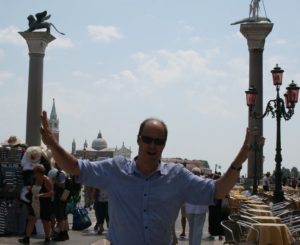

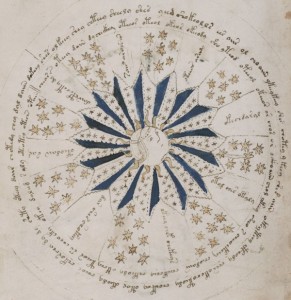

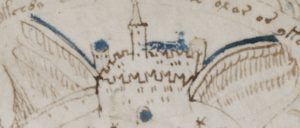
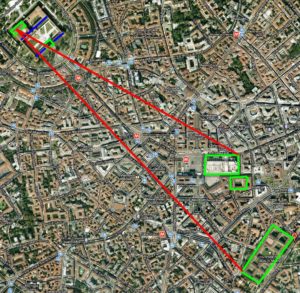
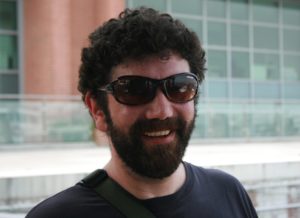
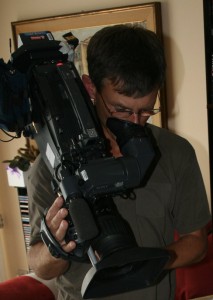

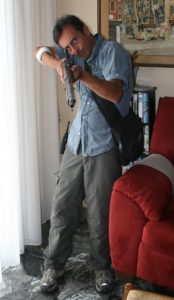

I’d love to see that film. Hope to read the ‘Curse’ too.
PS – if the -C14 dating ever alters, I’m moving de’ Conti from back burner to the table.
According to your theory, Antonio Averlino wrote it, then the original language of the author was (presumably) Italian. So if there is any kind of code in the VM, it is coded with the original language in Italian.
Are there any writing samples of Antonio Averlino to compare to VM?
apprentice: yes, and moreover it turns out that Averlino had his own herbal, elegantly written in the vernacular tongue (i.e. Tuscan). However, all we have of his (as I understand it) was written by scribes for presentation to his patrons, rather than by him. So unfortunately – unless some passing art historian can correct me – I think we don’t have any of his writing. 🙁
Is there any chance at all that you will be “comped” a courtesy copy if your latest “Da Voynich” adventure gets filmed?
How ’bout that smile?! I bet “Mona Lisa” wasn’t the only one who got captured in a “meditative” moment.
%^
How does Averlino own herbal compare w/VM? both subject topics and actual art/pictures? Are they chimeras? do they show similar strokes/paint/coloration ?
Nick, we loved the pics and your summary from the shoot. We enjoied that so much and we had very good fun..!!
Hope to see you very soon back to Italy.
Ciao from Cesira & Dario
Cesira & Dario: I hope to see you both soon too! Will you be anywhere near Frascati this Thursday / Friday / Saturday [10/11/12 May 2012]? 😀
Q. Why does time fly?
A. Obvious – pinions and escapes.
(It’s a clock joke)
Diane, …oh, groan!
Nick, Your mention of your Naples adventure ticked my “Kircher” clock:
Several weeks ago I compared Esther Molen’s translation of the “Michitonese” with a phrase that Kircher used in his published Mundus Subterraneus. Since then and yesterday, I was finally able to find a valid link (Stanford apparently no longer has it online):
http://ouhos.org/2011/09/14/athanasius-kircher-mundus-subterraneus-1665/
Here’s the phrase:
“Having a very earnest desire, a long time, to understand the Miracles of Subterraneous Nature…I found such a Theater of Nature, displaying herself under wonderful variety of things, as I had with so many desires wished for. (Seeing) what ever thing occurs, in the whole body of the Earth that is wonderfull, rare, unusual, and worthy of Admiration, I found contracted here, as it were, in an Epitomie, by a certain industry of wise and sagacious Nature.”
OU’s writer went on to say: Kircher included sketches of active volcanos such as Etna, Vesuvious, and Stromboli described on the basis of first-hand observations. During a sea-voyage to NAPLES (emphasis mine, bd) in 1638, Kircher witnessed smoke plumes, tidal waves, and the tragic loss of the city of San Eufemia.
There is more, but I thought as long as you may be seeing some of your Naples friends in Frascati, you might enjoy this tidbit of info.
Get yourself a little battery-operated hand fan. Another gadget you can probably find would be an aerosol pump-straw that you could stick into your bottle of water to spritz yourself and then fan yourself cool and dry!
btw: That’s Oklahoma University (many years ago I attended a two-week seminar there). Some of the politest and most helpful people in the world teach and live thereabouts.
apprentice: alas! Although Averlino’s herbal was mentioned by Giovanni Michele Alberto [see MS Ashburnham 198, fol. 78r], it seems that no obvious sign of it remains. Unless, of course, we’re in some way staring it in the face… 😉 Anyway, here’s a link to a post from 2008 with a few more details on this whole story: http://ciphermysteries.com/2008/05/08/research-breakthrough
Punny song: …knick knack paddy-whack, give a dog a bone…..
Wal, Nick, you’ve given us a bone to chew on! I found a rather interesting web-site to entertain/educate? us while you’re in Frascati. Hopefully some of your friends from Naples will be at Frascati, too:
Naples under the Double Eagle (I’m not very good at typing the entire link).
Nick:
I took another look at the clock. I also took another look at the figure that appears in the center of the matching drawing:
Could that be a “tonsured” head that appears in the drawing?
Were you able to get a look/photograph of the figure that appears in the actual clock? If so, can you tell us anything about it?
Hey Nick,
Just watched that program in South Africa, which was of interest to me because my friend, the late Terence Mckenna, got me interested in it. I’m sure he would have been as impressed with your logic and explanation as I am.
Of interest to you may be the documentary series I’m busy with right now; ‘The Terence Mckenna OmniBus 2012’, a 12 part series being released as 12 minute webisodes through 2012 in webHD.
Best wishes for your next endeavour!
Mike Kawitzky
Producer: The Terence Mckenna OmniBus 2012
Pingback: » Il Prof. Filippo SINAGRA Socio A.R.S.!
Spent my leisure hours last week watching the great number of amateur ‘cover versions’ of the Voyich history.
A relief to watch this original documentary again today.
(May I add that my recent postcard was a lighthearted look at the young’uns ‘covers’ – not the Nat.Geo sort).
What I wonder is if the Nat.Geo. documentaries were the first. Has Voynich-on-film devolved to the flood of YouTube covers, or did they spark the interest of professionals?
Cathedral-to-Bazaar or vice-versa?
Hi,
I have an update for Cotone Castle which I believe the Voynich Manuscript was coded near or around that area.
In 1530 the castle was the object of an architectural makeover by the Sienese military architect Baldassarre Peruzzi, who substituted the crenelations of the towers and walls with the roofs that we see today. Additional restoration followed. The final restoration done in the second half of the last century gave us back its original ancient magnificence.
Nick: Is there a way to get hold of this documentary? Also I have emailed you a challenge. Thanks!
Nick: I am contemplating a visit to Milan, Novara etc. though I will have to do quite a bit of preparation before hand to ensure the time is used most productively whilst I am there. I most likely will also visit the Vatican Archives. I may be able to look into a couple of things in Italy on your behalf whilst I am there. I may also ask you if you can refer me to any contacts there that you think suitable when the time comes.
I very much doubt I will find the time or a good enough reason to visit German Switzerland on this trip.
Just thought I would let you know my plans.
To visit the Vatican archives, you may need a letter of introduction. At least that is how it used to be in the past. Better check this beforehand.
Rene: I will do. Thanks
Nick: Out of curiousity, are the complete Milanese cipher ledgers available online?
Mark: scratchy monochrome scans of them were placed online many years ago by Petr Kazil, but I don’t know if they’re still accessible there.
Nick: I am concerned that we have no Milanese cipher records from the early 15th century.
I have been wondering. Presumably if a enciphered message was sent from Milan to another institution then the other institution would have a copy of the enciphered message. Now I can imagine this message would have often been destroyed. However I wonder if an enciphered message was sent to the papacy it would be more likely to have survived more so than with other institutions. I know of instances when there would have certainly been communication with the pope.
Again I have no idea how easy it is the find what you are looking for in the vatican archives. An early 15th century Milanese cipher might be very illuminating and it might not.
Do tell me if you think I don’t know what I am talking about and if I am completely off track.
Mark: the Milanese archives are very patchy for the pre-1450 period, mainly because of the chaos of the Ambrosian Republic that preceded Francesco Sforza’s siege and takeover.
Nick: Thanks for mentioning that. Yes, I realise the situation vis a vis the end of the Ambrose republic in 1450 and the destruction of all their records. I believe that finding some record of Milanese ciphers elsewhere from this earlier period could potentially provide a very valuable clue to the cipher. I wonder if it is a vain hope that there might be some record of enciphered correspondence between the Milanese government and the papacy in the Vatican archives. What is your opinion?
Certainly if you find a large block paradigm crib that would be invaluable, but I think it definitely worth pursuing other potential clues to the cipher until such a time.
Nick: I rewatched your Ancient X-files episode. The narractive of the events and the process of your construction of your theory is I assume manufactured for television rather than reflecting real events. Is that so or did you really develop your theory during the events of the television programme? Or is it a reconstruction of the process or events of your previous research?
The reason that I ask is that I have been interested, as I said before, in the steps by which you actually developed your theory; the Curse does not explain, I think. This is useful information to me as it illuminates your deductive/inductive process which in some cases, given that my theory borrows something from yours, could help to put those few borrowed aspects within my theory on a firmer foundation.
Nick: The implication from your documentary, as far as I can understand it, is as following:
1. Your starting point was, what I regard as, the very weak resemblance between the central rosette and St. Marks Basilica; which if it was the starting point seems very poor foundations on which to build a theory.
2. Then you are lead to Milan by the “4o” character and the circular city.
3. Then you are lead to Averlino.
Obviously the step that interests me is step number 2. The strength of the case for the identification of Milan is core to my theory, so the precise means by which you arrived at that identification is of great interest to me as it helps me to examine and hopefully justify the foundation of my theory. Obviously you have presented a sequence of your argument, but not the precise real sequence in which your ideas developed which is most illuminating to me.
Mark: initially, my interest in Milan was triggered by the appearance of the ‘4o’ shape in a number of the ciphers in the Sforza ledger in the 1450-1460 date range, along with the idea that the castle with the swallowtail merlons might be Castello Sforzesco in Milan.
Then, while reading up on that period, I discovered Antonio Averlino’s books of secrets, and formed a tentative hypothesis that the Voynich Manuscript might in some way be an encrypted version of those. That led to a ton more reading (in lots of languages).
I then tried to form an reading of the circular diagram in the top-right rosette, based around the spirals being some kind of representation of Milan’s canals. To test this, I flew to Milan and tried this out: it was a bust (apart from San Gottardo). However, this led me to circular maps of Milan (I saw one on a poster in the Castello Sforzesco), and went from there. Again, I bought a whole load more books on Milan and circular maps.
My identification of the central rosette with the onion domes of San Marco in Venice I stumbled across along the way (looking at a book while at a friend’s house): and when I then had the opportunity to go to Venice and take photos from the top of the Campanile for myself, I was utterly convinced. Incidentally, the perspective you get from the current top of the Campanile is slightly different from what you see in the Voynich, but the Campanile was actually slightly shorter in the mid-fifteenth century (not a lot of people know that).
Obviously the TV documentary dramatized this whole sequence (hopefully in a fun it’s-only-television-don’t-take-too-much-notice way). And it’s easy to misrepresent or misunderstand the order in which I took the various steps. But now you know. 🙂
Incidentally, I found a whole lot of really cool Voynich things at the top of the clock tower just diagonally opposite San Marco, but the film makers didn’t include them in the final edit. I’d have to go there again and take a load of photographs to reconstruct what I found.
Nick: You are a superstar as always! It does help.
You see Milan, top left rosette of course, is the first step in the development of my “map”, so if it is correct I need to be able justify it as well as I can. Obviously I have a variety of arguments, but for example the “4o” identification with Milan is an important one. If I can also justify the identification of Milan by the script that is important. Now as you have pointed out in another post I believe we do only see the “4o” in Milanese ciphers, but nevertheless there may be grounds for most strongly and with greatest probability tying that symbol to Milan.
My steps are as follows:
1. Top right rosette
2. Top right to Top centre causeway
3. Top Centre to Top left causeway
4. Bottom Left rosette JUMP TO THIS
5. Bottom Left to bottom centre causeway
6. Bottom Right rosette JUMP TO THIS CRUCIAL STEP
7. Top Left rosette JUMP TO THIS LARGELY NON-VISUAL IDENTIFICATION
8. Top Left to Centre Left causeway
9. Centre Left rosette
10. Centre Left to Bottom Left causeway
U. Centre Right to Top Right ANY STEP AFTER STEP 1
V. Top Centre rosette ANY STEP AFTER STEP 3
W. Centre Right rosette ANY STEP AFTER STEP 1
X. Bottom right to Centre right causeway ANY STEP AFTER STEP 6
Y. Bottom centre to bottom right causeway ANY STEP AFTER STEP 6
Z. Bottom centre rosette MOST UNCERTAIN IDENTIFICATION
There are other valid non-deductive approaches nevertheless I am also exploring this method of argument and in fairness it best mirrors the steps by which I developed my theory.
Nick: I like your Little Book of Secrets argument, but the St. Marks central rosette identification I strongly feel cannot be correct. When developing my theory I left open the possibility that you were right about the central rosette as I concluded you were right about many things, but for so many reasons, independent of my theory, unfortunately I could not justify that identification.
Mark: unfortunately, ‘4o’ appears in other ciphers from other Italian city-states of the early 15th century, so the argument’s starting point turned out to be not quite as strong as I originally suspected. But that’s another story. :-/
You don’t have to look to ciphers to find 4o. It’s a Latin scribal abbreviation used in several languages.
4o appears in thousands of manuscripts.
I have samples, but I don’t see a need to post them, because it was a common Latin scribal abbreviation for “quarto” (4 + o) in the same manner as abbreviations for “grado” (g + o) or modo (m + o). This form of “4” (the sharp one like a modern 4 that superseded the one that looks like EVA-l) was coming into use in the early 15th century, common by the middle 15th century, and dominant by the end of the 15th century.
JKP: If they are commonplace it should be very easy for you to post them or just provide a link to an example.
Nick: As I said, the Meister Florence 1424 cipher key contains the “4o”. However my point was that there may be a much greater usage of the “4o” in Milanese ciphers hence Filippo Sinagra identifying it with Milan. In addition the “4o” may be used in Florence and Milan, but say not Venice and Rome.
The evidence doesn’t really point to there being a 4o character in the VMS.
• The 4 character precedes numerous other glyphs in the VMS besides “o”.
• The 4 + o sequence sometimes has apostrophe characters above it (usually a straight macron or a curved macron). In languages that use Latin, macrons are like apostrophes, they indicate missing letters, so if VMS text honors this convention, there are missing letters between the 4 and the o.
• Tokens that begin with “o” are very frequent in the VMS and most of the VMS glyphs are positional, so it may be that 4 simply precedes “o”-words more often than others and superficially looks like a “4o” combination when, in fact, it’s 4 + otedy or 4 + okain and others.
• Some tokens that appear to begin with “4o” are written differently, the “4” is very rounded and almost indistinguishable from medieval “q”. This token might be the same as “4” and it might be something different—they cannot be assumed to be the same without carefully examining the evidence. If they ARE intended to be the same, it increases the probability that the shape (if not the meaning) is based on the number 4, because in the early 15th century, the number 4 was written both pointed and rounded (it was a transitional period). If they are intended to be different, then maybe the pointed 4 shape is an offshoot of the “q” shape and has nothing to do with cipher shapes.
Even if SOME of the 4o combinations are units (I think it’s pretty clear that not all of them are and it’s possible that none of them are), it’s a common Latin abbreviation for quarto, which means the shapes exist in languages that use Latin scribal conventions and thus one cannot be said with any certainty that the idea for the shapes came from ciphers.
Nick: Many years ago I read a book by Imre Lakatos where he argued that Mathematics should be taught in the way it was invented. When one reads a text in Mathematics one can see just the end of the process of theory building, but not necessarily how the theory was thought up and created. The reader cans see the ideas presented where all the loose ends have been tied up and the theory is neat and elegant. He felt that however this was a bad way to train people doing research into Maths as they would be less familiar with the process of how ideas and theories are arrived at. Of course it could be argued that textbooks may have to be that much longer if that approach was taken. Anyway, I, personally, have had for a long time a lot of sympathy for approach, though I don’t think it has caught on at all.
For some time I have been interested in how your theory evolved as in some respect it underpins my own ideas, as you know. I considered a lot of possible geographical locations and explanations for the Top Right rosette and was satisfied with none of them until I considered your Milan hypothesis. Now I may have ended up considering Milan eventually independently of your ideas or I may never have considered it, that remain unknown. However, as it is, the evolution of my theory is dependent on your idea about this. Now neither the Curse nor this documentary I think illuminate how your ideas really developed; the documentary seems very much “made for television”.
So I wonder in what sequence your thinking evolved and to what extent it drew from the thinking of others when it came to associating Milan with the Voynich and in particular that rosette on the Rosettes folio.
You could have looked at the Tranchedino and so associated the Voynich with Milan, due to the similarity in some of the symbols used in that cipher ledger. Or you could have looked at the top right Rosette and observed similarities to maps of Milan that you had seen. Which came first and which association was more important would certainly be of interest to me. Or you could have been aware of someone else’s suggesting associations between Milan and the Voynich and developed their ideas further; in which case the question would become how did they associate the Voynich with Milan.
The reason for my curiousity is that I would like to have a complete chain of reasoning. Whilst it may be correct, it is unsatisfying being only able to justify one of the ideas that is part of my thinking by reference to someone else’s thinking without knowing the basis for that thinking.
I have also been contemplating for sometime whether when writing up my own thinking I will employ Lakatos’s approach as to how my ideas developed rather than just prevent the end result.
Mark: I understand the concept well enough, but the challenge there would be fitting the complete trail into even 1000 pages.
Having said that, I could certainly identify various key stages in that overall development: for example, a very early step (which, to be fair, I can now see to have been well-intentioned but overspecific) was positing a connection between Voynichese’s 4o and the 4o that appears in several Milanese ciphers, and drawing a link specifically from there to a Milanese milieu for the cipher system. Part of the logic around that involved my belief that we saw freestanding 4 (i.e. not followed by o) much more than we do, which would seem to place Voynichese in the specific family of cipher keys that include 4 and 4o (which, again, I’m now not so sure about).
I doubt more than a small number would be interested in a forensic deconstruction of the 50+ stages that took me from the start line to the end line, but perhaps it would be an interesting exercise to attempt even part of that.
Nick: It is an interesting point regarding the question of the association of the 4o symbol with Milan. From my point of interest, can I say that in the early 15th century 4o is associated with Milan? The answer is that due to the limited quantity of examples of early 15th ciphers either from Milan or elsewhere it is hard to draw any definite conclusions. (As you know I am seeking more examples of early 15th century ciphers) You have pointed out, the earliest known occurrence of 4o in a cipher was from the 1424 Florence cipher. When it comes to the prevalence of the 4o in ciphers from the middle to late 15th century, I haven’t studied the complete range of these in enough detail to be any to say anything definitive. I think it would be easy to infer a link to Milan from the presence of the 4o symbol in the tranchedino, however that could just be a result of having a rich quantity of ciphers from Milan for this period. A more general question is, for which city state are the cipher symbols as a whole most consistent with the cipher symbols that we have in the Voynich? Again, unfortunately I am reluctant to come to any strong conclusion for this question in the early 15th century. More careful and rigorous analysis on my part could provide a better answer. There is the question as to what extent the cipher symbols used by a state in the early 15th century are similar to those used in the late 15th century.
What can I say about Milanese ciphers in the early 15th century based on the few sources that I have? I would say that Milanese ciphers appear to be the most innovative and distinctive and very probably, based on the limited data that one has for that period, the most advanced.
I certainly wouldn’t say that you were wrong to associate the 4o symbol with Milan, but I am reluctant to say that you were definitely right in doing so. We see the 4o symbol in ciphers from Modena and Florence(I think it is in the Codex Urbinate, but I would have check where it occurs.) My inclination is to say that 4o is more closely associated with Milan on balance, but that is probably wishful thinking on my part. Associating the 4o symbol with ciphers and specifically Northern Italian diplomatic ciphers is, I would think an achievement in and of itself, and given that there were only a few major Northern Italian city states it certainly would mean that Milan would be under consideration.
I think it is striking that your interest in and knowledge of medieval ciphers pulled you in that direction. To me the natural initial expectation when looking at the Voynich script is that it is either a known or unknown language in an unknown script as one would find who is readily familiar with Egyptian hieroglyphics or Linear B or Cuniform or Chinese characters as well as many other ancient and modern language scripts. However few people are aware that in medieval ciphers the kind of invented symbols that we see in the Voynich were used. In fact few people have any acquaintance with ciphers except for the very modern variety which do not rely on the use of obscure symbols. So finding the link between medieval cipher symbols and the symbols of the Voynich is a non-trivial accomplishment. Once that link is established the geographical origins of the Voynich are greatly reduced and Milan, Venice, Rome, Florence all enter serious consideration. So it is makes sense that this was an important early step in associating the manuscript with Milan.
Nick: I appreciate that documenting all of one’s thinking on a subject would be arduous and frankly one tends to forget a lot of what one has thought. (In my own theory, I am not quite sure as to how exactly the idea of “cloisters” entered my head.) In addition one’s ideas changes, so there are inevitably twists and turns in one thinking as one’s theory evolves. One thing that I think will be difficult to convey in my write up is the number of different possible towns/cities that I considered for the top right rosette; I could list them, but then justifying why I rejected each would be a long piece of work. However nevertheless I will be faced with the question as to why I think the top right rosette represents Milan and not somewhere else, which I will not be able to answer succinctly. Arguing why I think each and every small building represents the location that I think it does mostly like again seems futile and in general trying to justify my interpretation of many of the small very specific details to a high standard of certainty would be hard. I think it worth including those in my analysis as I think the key is the overall body of evidence not some kind of conclusive proof of specific details.
So I don’t think 1000 pages of your thinking is necessary.
I would only think that those people who believe there is some truth in your theory would have any interest in your 50 stages of reasoning. However there are clearly people who believe there is value in your ideas, so there might be some interest in your process of arriving at your conclusions.
My interest, as you know, comes from my desire to provide, if possible, a more complete justification for the identification of Milan on the Rosettes page. The top right Rosette identification is the starting point from which I develop my whole analysis of the Rosettes page, so it is a cornerstone of my theory. Now it is not vitally necessary that I justify the identity of Milan as the drawing is consistent with the layout of Milan and fits with maps of Milan from the time plus I think that following on from that identification the other identifications on the page that I make fit neatly and prop up the original Milan identification on that basis. Still, I am slightly aggrieved that my theory relies on a idea of someone else’s the formation of which I am not fully cognisant of.
It might not only be an interesting exercise for you to attempt even part of it, it might also help you to better understand your own thinking.
It strikes me as uncanny that my argument for my Rosettes theory parallels my own experience with the Travelling Salesman Problem or more generally Vehicle Routing Problems. One has to justify the route when viewing the whole and not each and every step independently. My arguments vis a vis cipher data are I think more straightforward.